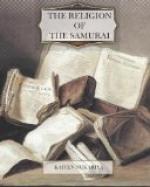[FN#204] ‘Personalism,’ p. 94.
[FN#205] Ibid., p. 95.
[FN#206] Ibid., p. 268.
[FN#207] Ibid., p. 271.
[FN#208] ‘Personalism,’ pp. 272, 273.
In the first place, Bowne’s conception of the physical organism as but an instrument for the expression of the inner, personal life, just as the telegraphic apparatus is the instrument for the expression of messages, is erroneous, because body is not a mere instrument of inner personal life, but an essential constituent of it. Who can deny that one’s physical conditions determine one’s character or personality? Who can overlook the fact that one’s bodily conditions positively act upon one’s personal life? There is no physical organism which remains as a mere passive mechanical instrument of inner life within the world of experience. Moreover, individuality, or personality, or self, or inner life, whatever you may call it, conceived as absolutely independent of physical condition, is sheer abstraction. There is no such concrete personality or individuality within our experience.
In the second place, he conceives the physical organism simply as a mark or symbol, and inner personal life as the thing marked or symbolized; so he compares physical forms with paper, types, books, and libraries, and inner life, with literature. In so doing he overlooks the essential and inseparable connection between the physical organism and inner life, because there is no essential inseparable connection between a mark or symbol and the thing marked or symbolized. The thing may adopt any other mark or symbol. The black marks on the white paper, to use his figure, are not essential to literature. Literature may be expressed by singing, or by speech, or by a series of pictures. But is there inner life expressed, or possible to be expressed, in any other form save physical organism? We must therefore acknowledge that inner life is identical with physical organism, and that reality is one and the same as appearance.
18. All the Worlds in Ten Directions are Buddha’s Holy Land.
We are to resume this problem in the following chapter. Suffice it to say for the present it is the law of Universal Life that manifoldness is in unity, and unity is in manifoldness; difference is in agreement, and agreement in difference; confliction is in harmony, and harmony in confliction; parts are in the whole, and the whole is in parts; constancy is in change, and change in constancy; good is in bad, and bad in good; integration is in disintegration, and disintegration is in integration; peace is in disturbance, and disturbance in peace. We can find something celestial among the earthly. We can notice something glorious in the midst of the base and degenerated.
’There are nettles everywhere, but are not smooth, green grasses more common still?’ Can you recognize something awe-inspiring in the rise and fall of nations? Can you not recognize something undisturbed and peaceful among disturbance and trouble? Has not even grass some meaning? Does not even a stone tell the mystery of Life? Does not the immutable law of good sway over human affairs after all, as Tennyson says-




